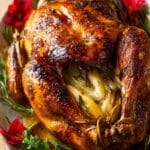Christmas Roast Duck With Cranberry-Orange Glaze Recipe
This festive Christmas Roast Duck recipe features a crispy-skinned duck seasoned with paprika, pepper, and garlic powder, roasted to perfection and finished with a luscious cranberry-orange glaze. The duck is stuffed with fresh herbs, onion, and lemon to infuse the meat with bright, aromatic flavors. The glaze combines tart cranberry juice, sweet orange juice, molasses, warm spices, and a hint of cayenne for a perfect balance of sweet, tangy, and spicy notes, making this dish a show-stopping centerpiece for your holiday feast.
- Prep Time: 20 minutes
- Cook Time: 2 hours 20 minutes
- Total Time: 2 hours 40 minutes
- Yield: 4 servings
- Category: Roasting
- Method: Roasting
- Cuisine: American
Ingredients
For the Duck
- 1 whole duck (innards and gizzards removed)
- 1 onion (quartered)
- 1 lemon (quartered)
- Several sprigs of rosemary, sage, and thyme
- Salt (for seasoning)
- 1 teaspoon sweet paprika
- 1 teaspoon pepper
- 1 teaspoon garlic powder
For the Cranberry-Orange Glaze
- 1 cup cranberry juice
- 1/2 cup orange juice
- 1/4 cup unsulphured molasses
- 2 cinnamon sticks
- 1 garlic clove (grated or minced)
- 2 teaspoons freshly grated ginger
- 1 teaspoon balsamic vinegar
- 1/4 teaspoon salt
- Pinch of cayenne pepper
- 2 teaspoons cornstarch
- Splash of cold water
- 1/2 teaspoon fresh orange zest
Instructions
- Prepare the Duck: Pat the duck dry using paper towels and trim any excess fat opposite the cavity. Score the breast skin in a criss-cross pattern with a sharp knife without piercing the meat to help render fat and create crispy skin.
- Stuff and Season: Stuff the duck cavity with the quartered onion, lemon, and fresh herb sprigs (rosemary, sage, thyme). Tie the legs together to secure the stuffing. Pat the duck dry again to remove moisture, sprinkle generously with salt all over, then refrigerate uncovered for at least 8 hours or up to 24 hours to dry the skin further and enhance crispiness.
- Preheat and Season: Remove the duck from the refrigerator 30 minutes before roasting to come to room temperature. Preheat the oven to 425°F (220°C). Mix paprika, pepper, and garlic powder, then rub this spice blend evenly over the duck skin.
- Setup for Roasting: Line a roasting pan with foil and place a rack inside; alternatively, use a large baking sheet with a wire rack. Put the duck on the rack breast-side up. Insert a leave-in meat thermometer into the thickest part of the thigh, making sure it doesn’t touch the bone for accurate temperature readings.
- Roast the Duck: Roast the duck at 425°F for 15 minutes to start crisping the skin, then reduce the temperature to 350°F (175°C). Continue roasting until the internal temperature reaches 165°F (74°C), which typically takes at least 1 hour and 15 minutes depending on the size of the bird.
- Rest the Duck: Once the duck reaches the proper internal temperature, remove it from the oven, tent it with foil, and let it rest for 10-15 minutes to allow the juices to redistribute. Then carve and prepare for serving.
- Make the Cranberry-Orange Glaze: In a small saucepan, combine cranberry juice, orange juice, molasses, cinnamon sticks, minced garlic, freshly grated ginger, balsamic vinegar, salt, and a pinch of cayenne. Bring the mixture to a boil over medium-high heat, then reduce to a simmer and cook until it slightly thickens.
- Thicken the Glaze: In a small bowl, whisk together cornstarch and a splash of cold water to form a smooth slurry. Gradually whisk the slurry into the simmering sauce to prevent lumps. Bring back to a boil and cook for about one minute until the sauce thickens to a glaze consistency.
- Finish the Glaze: Turn off the heat and stir in fresh orange zest. Spoon some glaze into a small bowl for brushing, then brush the glaze over the duck in the last 15 minutes of roasting or just before serving. Serve remaining glaze on the side for dipping or drizzling.
Notes
- Scoring the duck skin carefully helps render the fat and achieve a crispy exterior without drying out the meat.
- Refrigerating the duck uncovered before roasting dries the skin, essential for crispiness.
- Using a leave-in meat thermometer ensures perfectly cooked duck without over or undercooking.
- The glaze can be made ahead of time and gently reheated before serving.
- If fresh herbs are unavailable, you can use dried herbs but reduce quantity as dried herbs are more potent.
- For best results, use unsulphured molasses to avoid bitterness in the glaze.
- Resting the duck after roasting allows the juices to redistribute, keeping the meat moist and tender.

